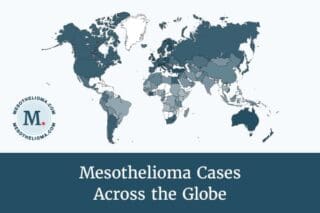
Global Asbestos Awareness Week is celebrated the first week of April each year. The Asbestos Disease Awareness Organization (ADAO) created the annual event to increase awareness of the mineral and help prevent further asbestos exposure. The week is also an opportunity to advocate for stricter laws and an asbestos ban.
Here are some of the latest asbestos news stories highlighting the continued risk the mineral poses around the world.
The EPA Releases a Draft Risk Evaluation for Asbestos
The Environmental Protection Agency (EPA) has been working on risk evaluations for ten chemical substances, including asbestos. The evaluations stem from the passage of the Frank R. Lautenberg Chemical Safety for the 21st Century Act in June 2016. The bill was an extension of the Toxic Substances Control Act (TSCA), which had long been criticized for failing to effectively regulate chemicals.
These evaluations will determine if any of the chemicals pose an unreasonable risk to environmental and/or public health. After the evaluations are complete, the agency may implement stricter legislation or bans.
In March 2020, the EPA released the Draft Risk Evaluation for Asbestos. Their draft includes an evaluation of 33 conditions of use of the mineral.
The EPA had previously been under fire for only evaluating current uses of asbestos. In an open forum reviewing the agency’s scoping document, asbestos professionals and health advocates questioned why legacy uses were not part of the evaluation. Despite many past instances of asbestos still posing health threats, the agency decided not to include legacy uses.
Although this oversight in the evaluation seemed like a setback for advocates, the newly released draft shows promise for stricter regulations.
The EPA preliminarily identified asbestos posed an unreasonable risk in the following instances:
- The processing and use of asbestos diaphragms in the chlor-alkali industry
- The processing, use and disposal of asbestos-containing sheet gaskets for chemical production
- The use and disposal of other asbestos-containing gaskets
- The use and disposal of asbestos-containing brake blocks in the oil industry
- The use and disposal of aftermarket automotive asbestos-containing brakes, linings and other friction products
Overall, the agency noted unreasonable risk from asbestos among workers, occupational non-users, consumers and bystanders.
The report also identifies areas the agency does not view as unreasonable risk, such as importation of asbestos. However, this draft is not a final action or determination. Their findings in this preliminary assessment are subject to change following peer review.
The draft will now have a 60-day period allowing comments. The assessment will also undergo peer review by the Science Advisory Committee on Chemicals (SACC) in April 2020.
Asbestos in Philadelphia Schools Remains a Concern
In recent months, stories have continued to emerge about asbestos in Philadelphia schools. The concern first became prominent in 2018, when an independent investigation discovered some schools had millions of asbestos fibers present in high-traffic areas.
In fall 2019, a Philadelphia school teacher was diagnosed with mesothelioma. She had worked at two Philadelphia schools for more than 30 years. After learning of the diagnosis, the Philadelphia Federation of Teachers called on the school district to provide $100 million toward asbestos and lead removal.
Since then, at least 10 schools have been fully or partially closed because of asbestos, impacting hundreds of students. Some of the schools are closed indefinitely.
In January 2020, the Philadelphia Federation of Teachers filed a lawsuit against the district. The union claimed the district endangered the health and safety of school staff and students. That same month, Philadelphia School District’s Board of Education approved contracts to expand asbestos testing and abatement at schools.
While the city is working on mitigating the problem, these stories have sparked concern across the country. Many schools nationwide contain asbestos somewhere in their facilities. Most school buildings were built before 1980, when asbestos was at its peak use.
By law, schools must have asbestos management plans and undergo inspections every three years to identify any dangerous asbestos materials. In a 2018 compliance report from the EPA, the agency found one of ten regional offices had an asbestos compliance strategy for schools. The required inspections also fell short of the mandate, with many only taking place when school officials complained.
The FDA Works to Improve Cosmetic Talc Testing
Asbestos-contaminated talc has continued to pose a threat to public health. The U.S. Food & Drug Administration (FDA) has recalled various cosmetics for asbestos contamination.
Because of a recent voluntary recall of 33,000 bottles of contaminated baby powder, the House Committee on Oversight and Reform held a hearing for improving testing methods for talc. The first hearing took place in December.
Expert witnesses agreed the cosmetic talc industry went largely unregulated. The lack of standard testing for asbestos and other toxins leaves consumers vulnerable to exposure.
The FDA held a rare public meeting on testing methods for talc in February. The meeting joined experts from federal agencies, consumer advocates, testing experts and industry executives. The goal of the meeting was to make progress on developing a standardized method for testing asbestos in cosmetic talc.
The meeting addressed several problems with testing. First, labs use different methods, such as X-ray diffraction, polarized light microscopy or transmission electron microscopy.
In the previous hearing, expert witness Dr. William Longo, a scientist for Materials Analytical Services, LLC, claimed another test was most effective. He stated the heavy liquid separation (HLS) technique was the most sensitive. Other experts claimed a combination of transmission electron microscopy and polarized light microscopy would be the most sensitive and effective method.
Dr. Linda Katz, director of the FDA’s Office of Cosmetics and Color, explained that many labs interpret their findings differently. She claimed labs have different statistical procedures.
It can also be difficult to differentiate asbestos fibers from other elongate mineral particles (EMPs). EMPs are also considered dangerous and can lead to health risks. As such, experts at the meeting stated all EMPs should be included in laboratory analysis to better inform protection regulations regarding consumer health.
Although the meeting didn’t establish standards at this time, the FDA plans to review all recommendations and produce a white paper with clear guidelines.




